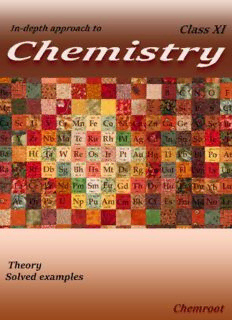
Indepth Approach to Chemistry Volume 1 for Class 11 Standard XI for CBSE ISc PU All Boards Satnam Sadeora Chemroot PDF
Preview Indepth Approach to Chemistry Volume 1 for Class 11 Standard XI for CBSE ISc PU All Boards Satnam Sadeora Chemroot
, Chemistry is basically an experimental science. In it we study physical and chemical properties of substance and measure it upto possibility. The results of measurement can we reported in two steps : (a) Arithmetic number, (b) Unit of measurement. Every experimental measurement vary slightly from one another and involves some error or uncertainty depending upon the skill of person making the measurements and measuring instrument. The closeness of the set of values obtained from identical measurement called precision and a related term, refers to the closeness of a single measurement to its true value called accuracy. 1.1 Significant figures. In the measured value of a physical quantity, the digits about the correctness of which we are surplus the last digit which is doubtful, are called the significant figures. Number of significant figures in a physical quantity depends upon the least count of the instrument used for its measurement. (1) Common rules for counting significant figures : Following are some of the common rules for counting significant figures in a given expression: Rule 1. All non zero digits are significant. Example : has four significant figures. Again x =1234 has only three significant figures. x =189 Rule 2. All zeros occurring between two non zero digits are significant. Example : has four significant figures. Again x =1007 has five significant figures. x =1.0809 Rule 3. In a number less than one, all zeros to the right of decimal point and to the left of a non zero digit are not significant. Example : has only two significant digits. x = 0.0084 Again, has five significant figures. This is x =1.0084 on account of rule 2. Rule 4. All zeros on the right of the last non zero digit in the decimal part are significant. Example : has three significant figures x = 0.00800 8, 0, 0. The zeros before 8 are not significant again 1.00 has three significant figures. Rule 5. All zeros on the right of the non zero digit are not significant. Example : has only one significant figure. x =1000 Again has three significant figures. x = 378000 Rule 6. All zeros on the right of the last non zero digit become significant, when they come from a measurement. Example : Suppose distance between two stations is measured to be 3050 m. It has four significant figures. The same distance can be expressed as 3.050 km or 3.050×105 cm. In all these expressions, number of significant figures continues to be four. Thus we conclude that change in the units of measurement of a quantity does not change the number of significant figures. By changing the position of the decimal point, the number of significant digits in the results does not change. Larger the number of significant figures obtained in a measurement, greater is the accuracy of the measurement. The reverse is also true. (2) Rounding off : While rounding off measurements, we use the following rules by convention: Rule 1. If the digit to be dropped is less than 5, then the preceding digit is left unchanged. Example : is rounded off to 7.8, again x =7.82 is rounded off to 3.9. x = 3.94 Rule 2. If the digit to be dropped is more than 5, then the preceding digit is raised by one. Example : x = 6.87 is rounded off to 6.9, again x = 12.78 is rounded off to 12.8. Rule 3. If the digit to be dropped is 5 followed by digits other than zero, then the preceding digit is raised by one. Example : x = 16.351 is rounded off to 16.4, again x = 6.758 is rounded off to 6.8. Rule 4. If digit to be dropped is 5 or 5 followed by zeros, then preceding digit is left unchanged, if it is even. Example : x = 3.250 becomes 3.2 on rounding off, again x = 12.650 becomes 12.6 on rounding off. Rule 5. If digit to be dropped is 5 or 5 followed by zeros, then the preceding digit is raised by one, if it is odd. Example : x = 3.750 is rounded off to 3.8. again x = 16.150 is rounded off to 16.2. (3) Significant figure in calculation (i) Addition and subtraction : In addition and subtraction the following points should be remembered : (a) Every quantity should be changed into same unit. (b) If a quantity is expressed in the power of 10, then all the quantities should be changed into power of 10. (c) The result obtained after addition or subtraction, the number of figure should be equal to that of least, after decimal point. (ii) Multiplication and division (a) The number of significant figures will be same if any number is multiplied by a constant. (b) The product or division of two significant figures, will contain the significant figures equal to that of least.
Description: